SEO Guide & Best Practices: How to Do SEO For Magento 2 Ecommerce Website
Author :
- What is SEO?
- What is Magento?
- What is Magento SEO?
- Magento 2 vs Magento SEO
- The Importance of SEO For Magento
- SEO Optimization of Magento URLs
- Use SEO-Friendly Meta Information
- On-Page SEO for Magento
- Indexing and Crawling in Magento
- Speed Optimization in Magento
- Technical SEO for Magento
- Off-Page SEO for Magento
- SEO for Magento Tools
- Cost of SEO for Magento
- Magento SEO Issues to Avoid
- Magento SEO Checklist
- How SEO Magento Contribute to eCommerce Success
- Conclusion
If you operate an online shop, you must be aware of the fact that the competition is insane. Millions of eCommerce websites are competing to draw visitors. To be fair, this is the only key to gain organic traffic.
Search engines remain the major source of traffic. That is where magento and SEO comes in.
If done right, it will increase your site ranking, help you find more buyers, and convert clicks into sales.
What is SEO?
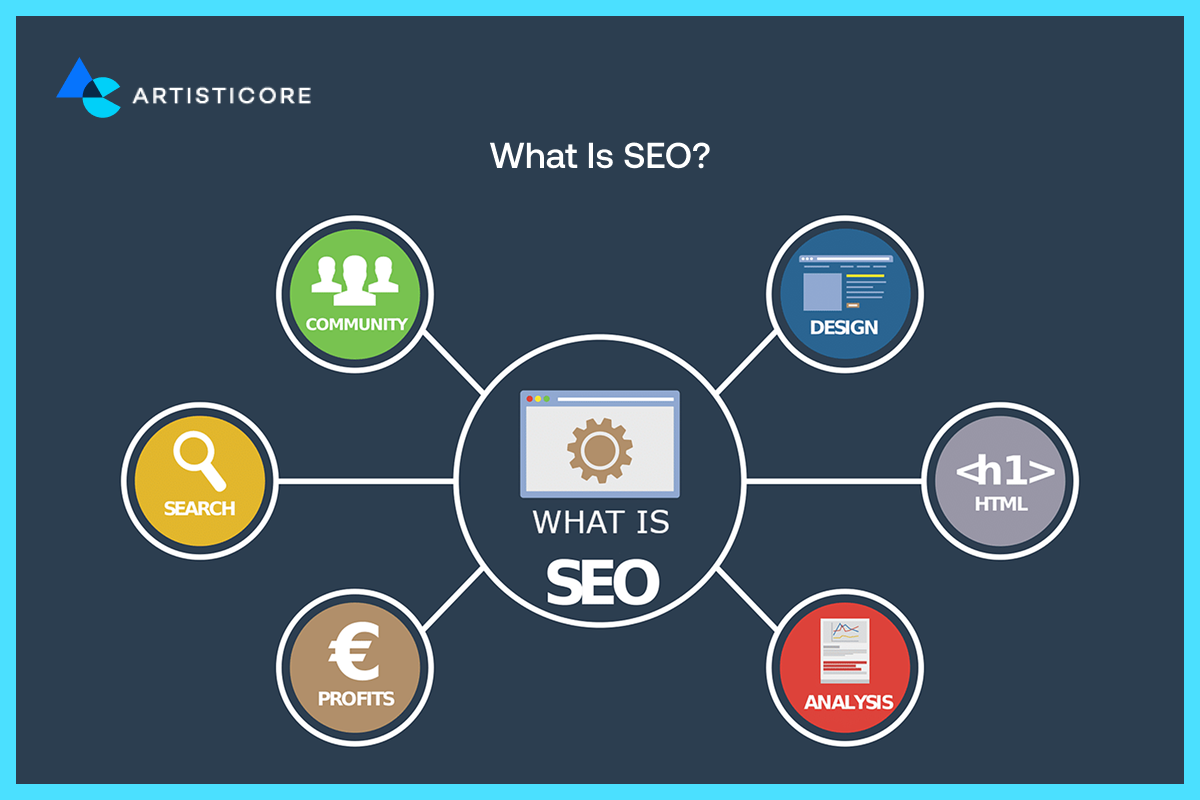
But stop a moment, what is it we are talking about? SEO which is Search Engine Optimization is the act of ensuring that a site is optimized to rank high on the search engines such as Google.
It appears whenever a person enters the keyword on the search bar. For example, they look for best running shoes or handmade candles and you shop sells any of these. Then you will appear on top only with proper SEO.
The power of SEO? Your site may remain unknown without SEO even if you’re selling quality products.
What is Magento?
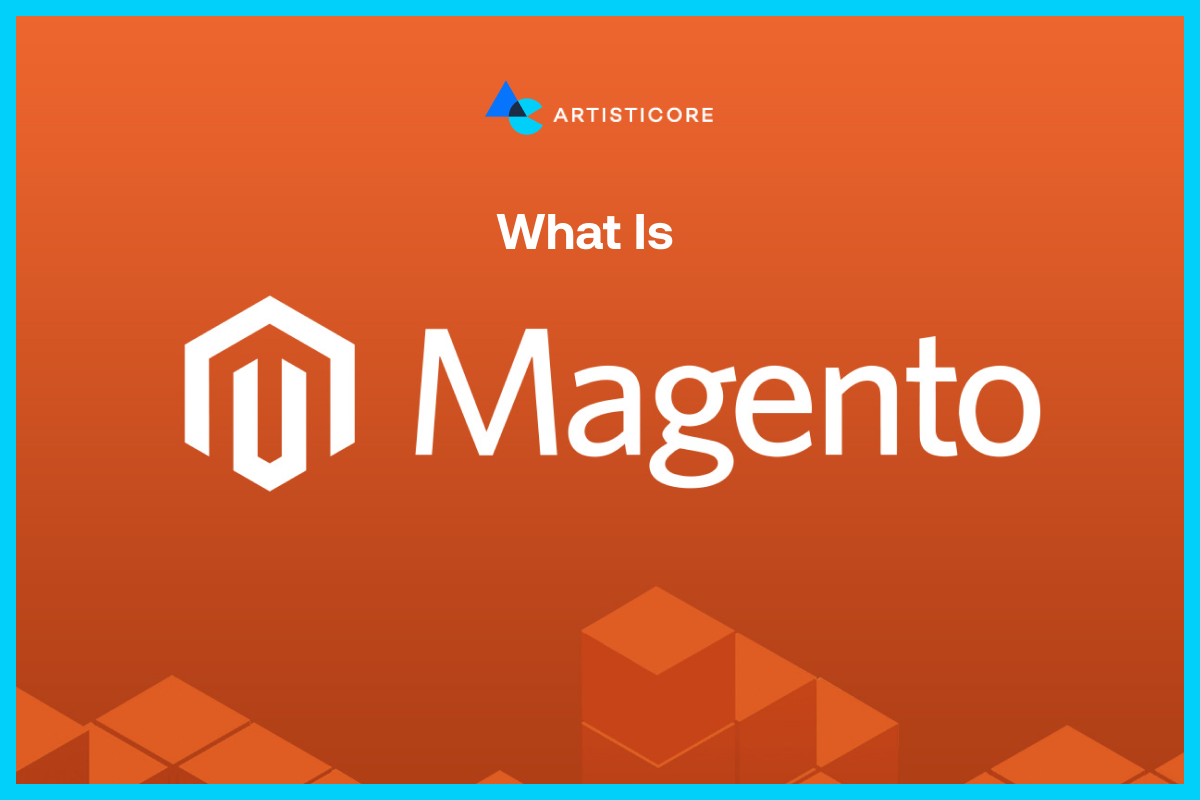
Now, what about Magento? Magento is an open-source eCommerce tool used by thousands of companies all over the globe. It is famous due to its flexibility, scalability, and large product catalogs.
There is a twist to this though,
Magento has excellent features, but it is not SEO-optimized right off the shelf. This is where magento SEO guide comes in.
At the end of it, you will have a clear understanding of how to optimize your magento store as much as possible to be more visible and grow.
Don’t want to get into the technical part? Contact Artisticore for your Magento Website
What is Magento SEO?
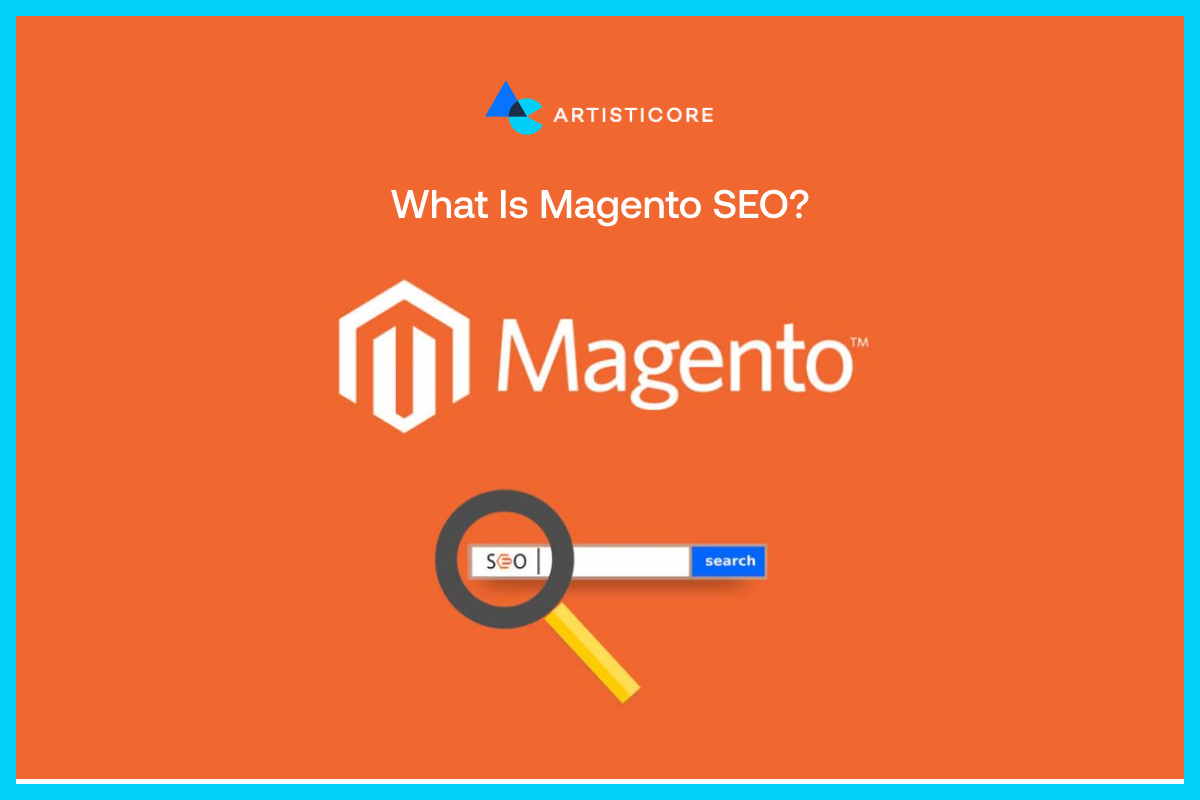
Let’s keep this simple. Magento SEO is the process of using the best practices of SEO to websites that are created on magento. It is not only about being ranked higher in Google but making sure that your products are at the right place, at the right time, in the right way.
Now the question is, how to do SEO on magento?
Here it does not match general SEO because all websites require optimization. In Magento, there are few challenges. For example, Magento will automatically generate different versions of product URLs.
Now this may cause problems such as duplicate content. However, it also introduces the ability to use personalized meta tags, create sitemaps, and rewrite URLs, which make SEO more effective when applied properly.
Consider SEO with magento as a combination of technical configuration, content optimization, and user experience enhancements. By using the right magento SEO tips and magento best practices, you are going to increase organic traffic, enhance conversions, and create a long-term visibility.
Magento 2 vs Magento SEO
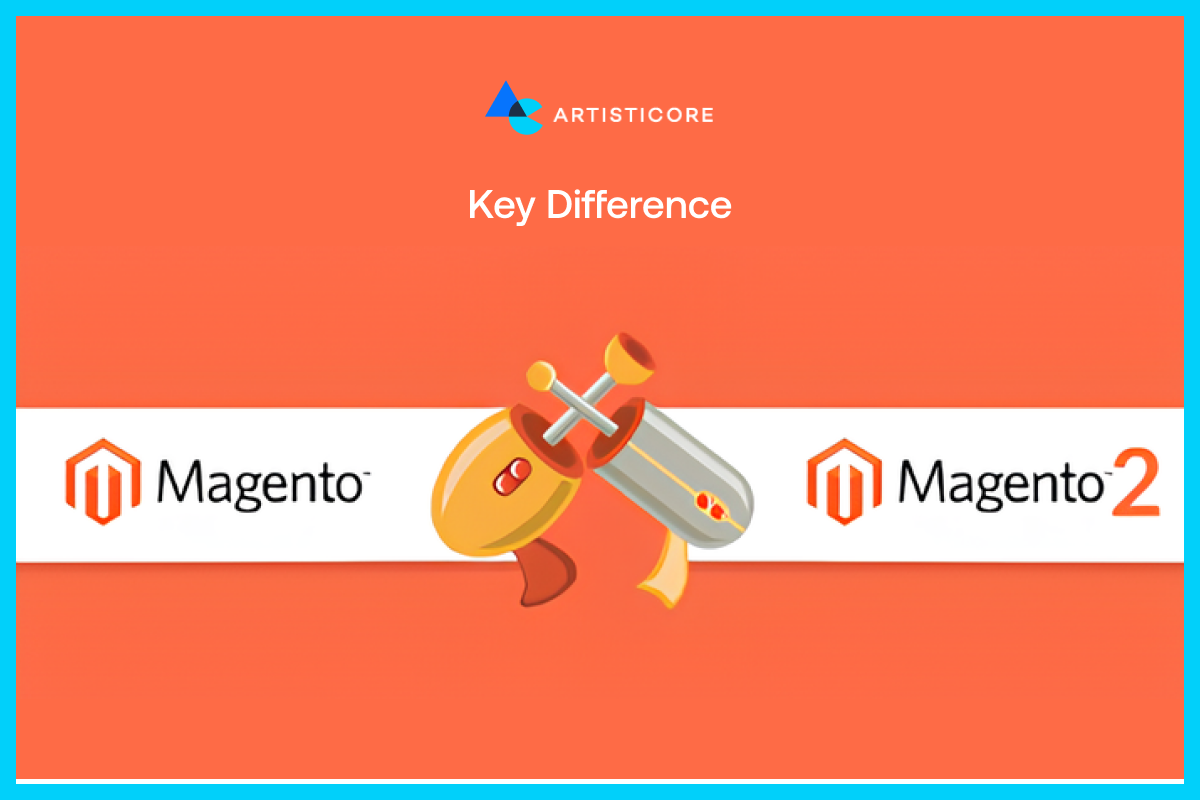
When one speaks of magento SEO or magento 2 SEO, they basically look for the differences in the strategies. The thing is that the fundamentals of both the magento on page SEO and magento 2 search engine optimization are the same. They both require good website structure, high speed, and efficient content.
However, magento 2 SEO optimization is easy to do because of inbuilt magento SEO features. This simplifies the process. For example, it has enhanced canal support, XML sitemap settings, and increased meta setting choices.
When you have an older Magento store, you can upgrade to Magento 2 to have a head start in optimization.
The Importance of SEO For Magento
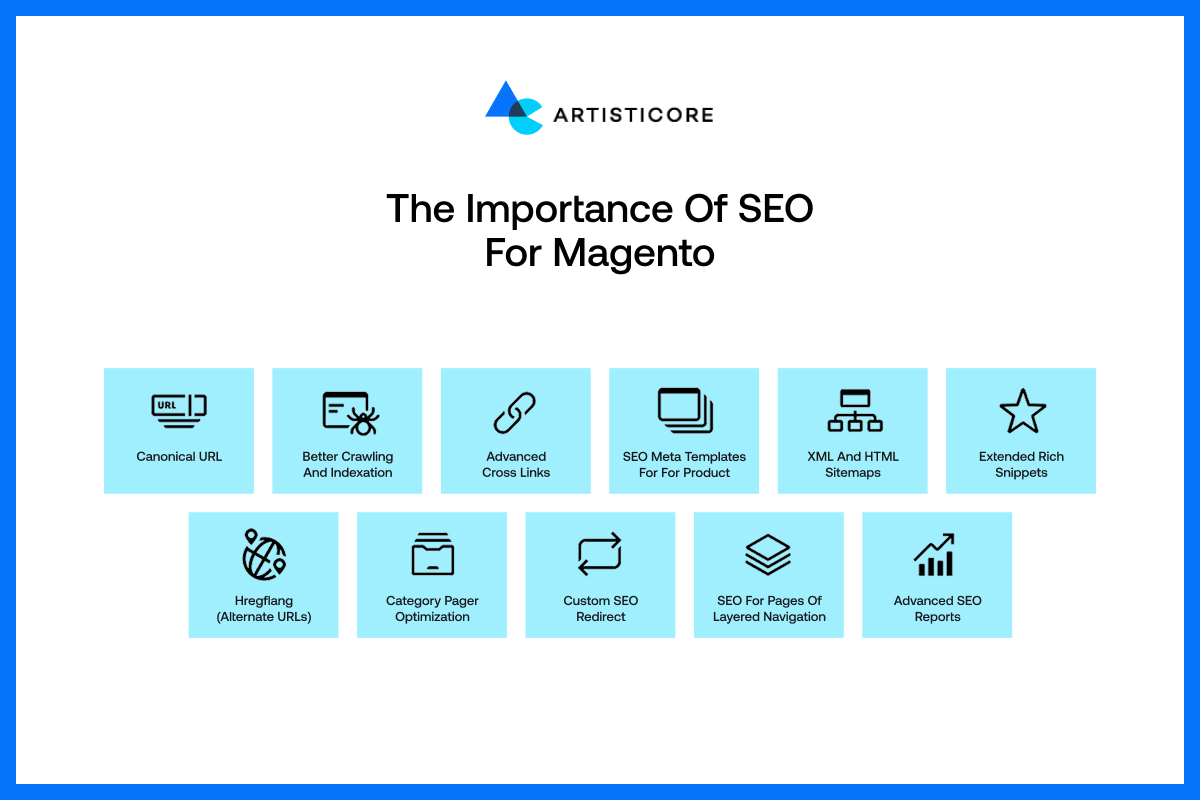
Magento is among the best options available to eCommerce companies. It is due to its ability to support small or enterprise-level stores. But the thing is, if your store is not optimized; you will not be noticed.
This is why SEO in magento is a game-changer. It helps to fill the gap between having a great store and being discovered by customers.
Think of a Scenario,
You might have a brilliantly designed site, with terrific products. But unless you appear in Google, you are just another shop. It is the search engine traffic that brings people to your store.
According to BrightEdge, 53% all website traffic drives from organic search. It is more than the number of paid ads, social media or email combined.
Speed is another reason why SEO is so important to Magento stores. According to Think with Google, every 1 second delay in page load can decrease conversions by up to 20%. That is, not only do slow sites rank poorly, but they also lose sales.
SEO in Magento 2 is not merely about keywords, it is also about performance, user experience and making the store adored both by the search engines and consumers.
SEO Optimization of Magento URLs
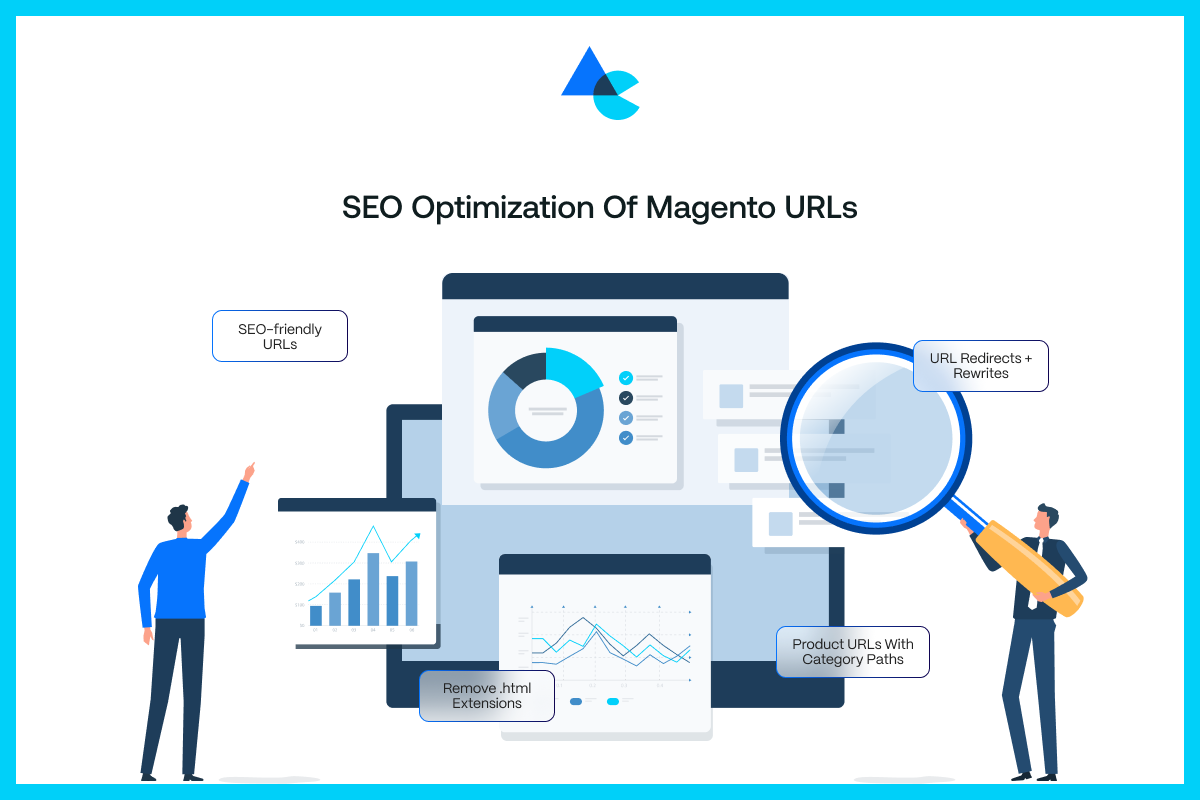
The second principle of SEO in Magento is to generate clean, sensible and search-engine friendly URLs. The URLs of your stores are a significant factor in how users perceive your content.
A messy link negatively affects visibility. Whereas a clean one positively affects ranking and general trust. Let’s talk about the essentials.
SEO-friendly URLs
Magento enables you to dictate how your product and category URLs should look. Ideally, they should be brief as well as heavy on the keywords.
For example, rather than a long string such as yourstore.com/productid=345?ref=shop, you should aim for yourstore.com/mens-running-shoes.
This helps customers easily see what that page is doing. It also assists the search engines to better classify your product.
Remove .html Extensions
Magento also includes a default .html extension to product and category URLs. Although this is not harmful, but it increases unnecessary characters. This act is not helpful in Magento SEO optimization.
Deleting the .html makes the link cleaner and more modern. For example, with extension, yourstore.com/mens-shoes.html, and without extension, yourstore.com/mens-shoes. You can see how the second one is short but looks more professional.
Product URLs With Category Paths
Magento allows choosing of category paths in product URLs. Though this might appear organized, it commonly results in lengthy, and difficult URLs. For example, yourstore.com/mens/shoes/running/mens-running-shoes. This may create duplication of content and mislead the search engines.
The solution is to turn off category paths and maintain the URLs on the product level. For example, yourstore.com/mens-running-shoes. Such URL make sure that your Magento ecommerce SEO remains clean. In this way, you can also avoid indexing problems and easily share all the product links.
URL Redirects + Rewrites
Magento will be able to create new URLs when product names are changed. This may cause broken links and damage to Magento SEO performance, unless redirects are provided. Always allow auto redirects as keys change. Also, with the URL rewrite tool in Magento you can modify URLs to support marketing campaigns or SEO. This is what makes SEO using Magento more advantageous, so your store will not have to contain duplicated content and will be well indexed in search engines.
Optimized and clean URLs does not require much efforts but they do leave a huge impact. Following these Magento SEO best practices, you will make the search engines crawl to your store. Most importantly, they will allow your customers to trust your links easily.
Use SEO-Friendly Meta Information
Meta information is a billboard to your online store. It does not just show on your web site per se but influences the appearance of your pages in Google search results. The use of optimized meta tags is also necessary in Magento search engine optimisation because it determines click through rates and rankings.
Products, Categories, Home Page Meta Tags
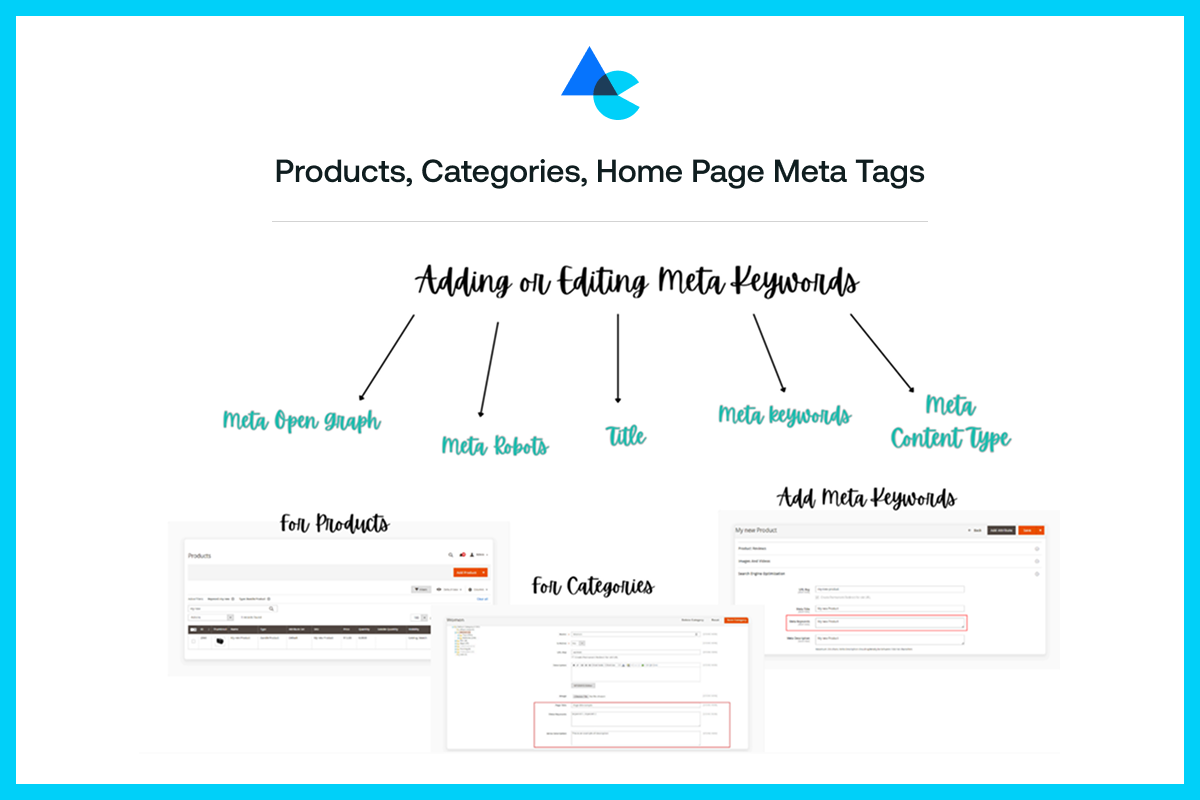
In Magento, every product and category contains meta titles, descriptions, and keywords fields. They are the areas that are central to Magento SEO capabilities, yet they are neglected by many store owners. In product pages, you should also use the primary key word and value-driven phrase.
For example,
Product Name: Men Running Shoes, Lightweight Performance Sneakers.
Meta Description: Men running shoes that are fast and comfortable. Free shipping on all orders.
This is how you make sure to use your focus keyword in the meta description. In the case above, they keyword is men running shoes appear both in the title and meta description. For different product categories, use different meta tags to prevent the issue of duplicate content.
Optimization of Title Tags (Prefixes, Suffixes)
With Magento, you can automatically add prefixes and suffixes to titles, such as adding your store name. Although this may aid in branding, do not cram the titles with repetitive text. Do not keep the main keyword at the end and be sparse in using the suffix. The right title is concise, contains your target keyword and is not more than 60 characters. This balance helps you to keep your Magento SEO marketing effort regular without key word stuffing.
Meta Description, Make a Unique Selling Point.
A meta description does not directly affect rankings, but it does affect the user clicking your result. Magento allows you to be able to write custom descriptions of every product and page. This is where you can summarize the product, mention the unique selling points and include your target key word in order to make it look natural. For example:
“Find lightweight men running shoes that are speedsters. Ideal to train or race. Shop now with free delivery”
This is a combination of keywords such as content that is Magento SEO friendly and persuasive language.
Using Templates in Magento
When you are dealing with a big catalog, it is daunting to custom-write meta tags on each page. Through Magento, you can make product and category templates. You can automatically format titles such as, “Buy Online at Nike.”
Templates allow you to be consistent and optimize Magento 2 SEO settings at scale without spending hours on custom adjustments. Do keep in mind to optimize the most vital products by hand, particularly your bestsellers and flagship lines.
Properly organized meta information means that your store does not only rank, but it also gets clicks. It is among the easiest, yet most effective Magento SEO advice to grow long-term.
On-Page SEO for Magento
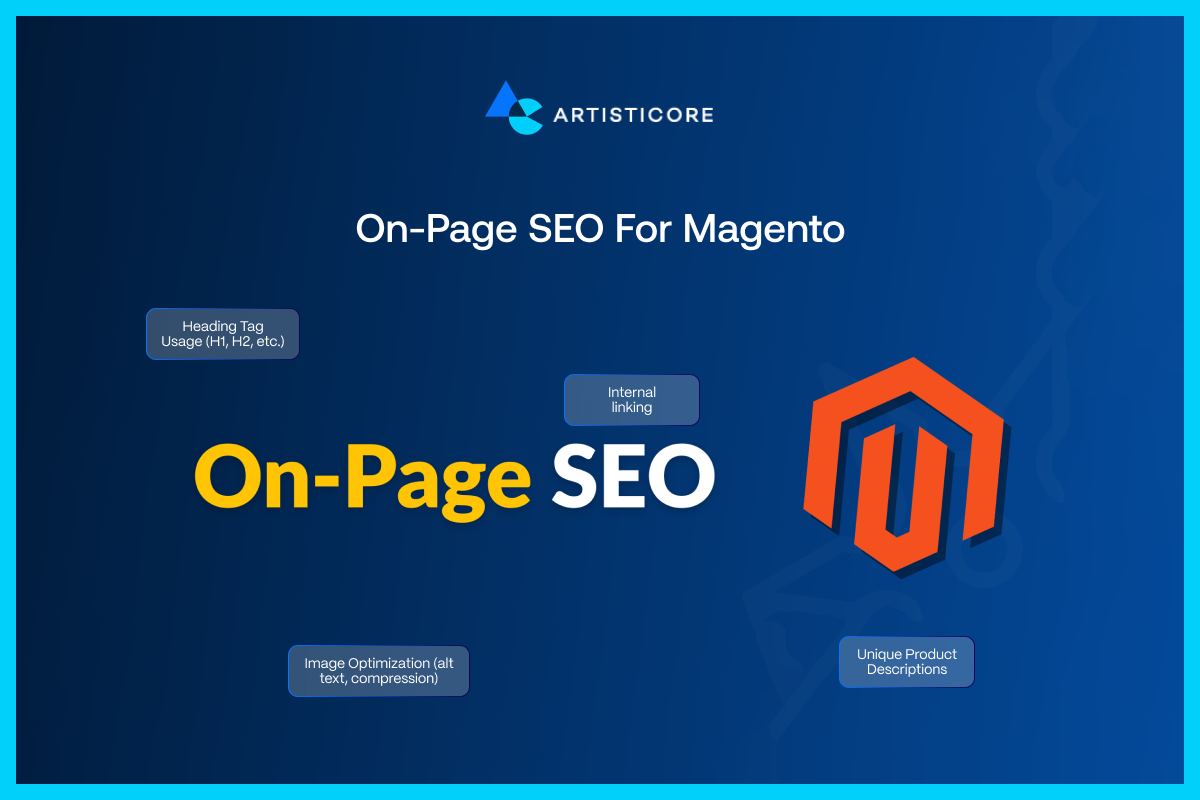
On-page SEO for Magento is about optimizing all the element that users observe on your store. It also makes sure that the search engine understands them easily and correctly. Remember, each product page, category page, and content block is a chance to increase the visibility.
Heading Tag Usage (H1, H2, etc.)
Magento automatically sets the H1 tags to product names and category names. But they are often misused by store owners.
Do not have more than one H1 on a page. You can use supplementary headings (H2, H3) to specify or review products. These sub headings play an important role in increasing readability and user experience.
Internal linking
The internal links can direct the shoppers and distribute ranking power. Connect related products, categories and blog posts in Magento.
For example, the connection between Men Running Shoes and Performance Socks will increase navigation and supports related SEO for Magento.
Image Optimization (alt text, compression)
Images of products are bulky and might slow down the speed of the site. Reduce their size without compromising quality. Add descriptive alt text and make sure it contains your key word, always. You should not write IMG123.jpg but lightweight men running shoes. Optimized images not only enhance usability, but also assist your shop to rank highly in Google images.
Unique Product Descriptions
Magento tends to repeat manufacturer descriptions, which is damaging to SEO. Paraphrase them, with keywords and emphasis of advantages. As an example, breathable mesh sneakers runners can use to be fast and comfortable. Exclusive content defines your product pages in saturated SERPs.
Good on-page SEO in Magento means that all the elements, including headings to images, collaborate to maximize rankings and conversions.
Indexing and Crawling in Magento
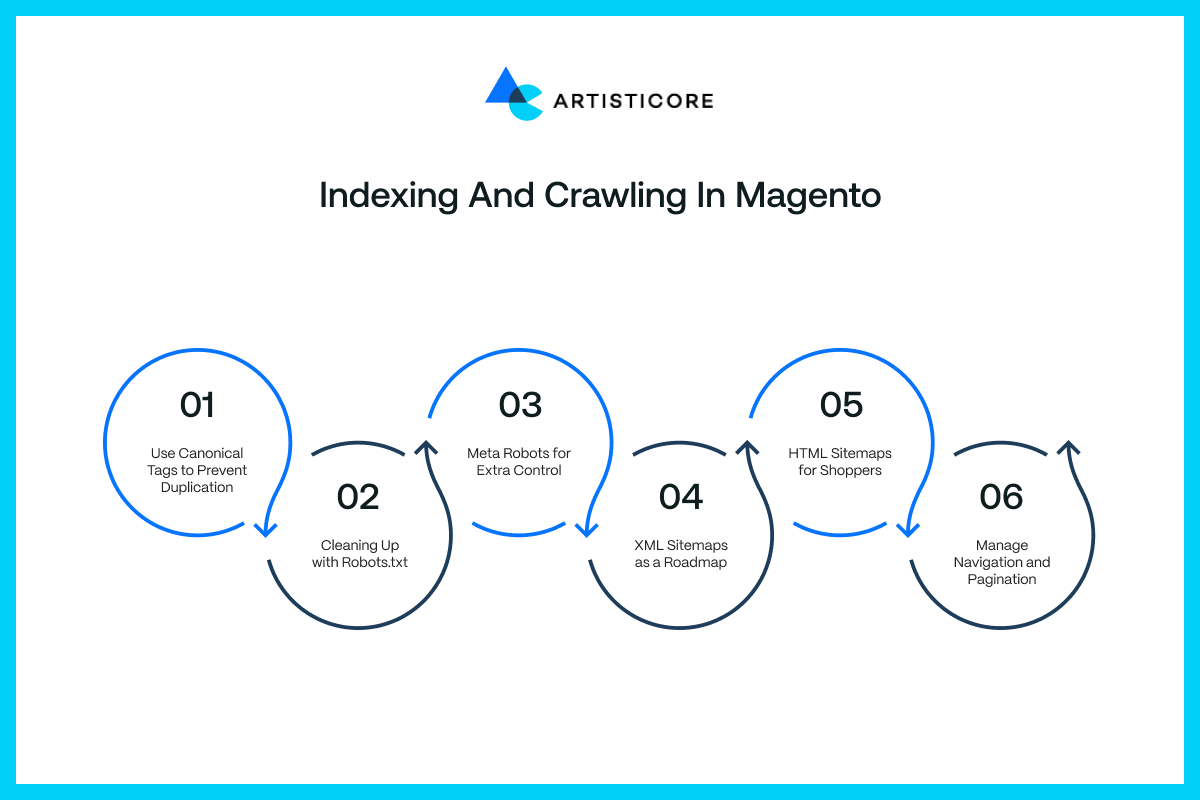
Imagine crawling and indexing as search engines visiting your store and getting to know it. Google locate your products and understand which version of a page is important. Only this way, you experience the best results of your SEO.
Magento is an effective tool, yet it may duplicate pages. This is why you have to direct search engines to their proper locations.
Use Canonical Tags to Prevent Duplication
Magento often display the same product in various categories. Without proper guidelines, search engines can make each version a different page. That is, it splits your ranking power.
This can be solved using a canonical tag. This help indicate Google which main page you want to index.
Suppose you have a footware brand and your sneakers are shown under New Arrivals and Best Sellers. Now, using the canonical tag will ensure that Google perceives which one is the original.
Cleaning Up with Robots.txt
The robots.txt file is like a map instructing the search engines. Sometimes, if often let the Google visit the places that do not need visit.
Now, such pages include checkout or customer accounts page. They do not require SEO and Google must not spend time there.
How will you let the Google know? Through clean robots.txt which makes crawlers focus on your product pages and categories that matter.
Meta Robots for Extra Control
In some cases, you require an additional control. That is where meta robot directives come in. These are magento 2 SEO tips that are placed on particular pages.
For example, shoppers apply a filter to their search results such as blue sneakers less than 100 or so. Now, when they do so, you do not want that filtered page to show up in Google. To achieve this, you will add a noindex derivative.
Basically, a noindex directive will allow customers to still use the page without it appearing on the search results. This action makes your store clean and clutter free in the Google index.
XML Sitemaps as a Roadmap
Sitemaps serve as a search engine tour guide. XML sitemap contains your key categories, products and content pages. It automatically updates itself as your store changes.
When you make any change to your site, Google gets it. It always has the most recent version of your site.
Both small or large shops use XML sitemap as a roadmap. However, large shops usually divide sitemaps into segments to keep things straight.
HTML Sitemaps for Shoppers
You can also make an HTML sitemap for shoppers. It is a basic page where you list your major categories and products in a single page.
It allows visitors to navigate more easily and provides search engines with a different way to locate your pages.
Manage Navigation and Pagination
Faceted navigation and pagination are the most challenging in SEO for Magento. Normally, magento generates unlimited pages when customers are searching by size, color, or price.
When you add in pagination, you see thousands of similar or close similar URLs. The fix? Filter out what do you need to index and block the rest.
In pagination, make sure that the engines knows if the pages are or are not independent content. This way, you can focus that the power flows to your main category pages rather than going to waste.
An Ongoing SEO Task
In Magento, crawling and indexing is not a one-time task. You have to check it as your catalog expands.
With the help of canonicals, robot rules, meta tags, and sitemaps, you can make sure that the search engines find the most appropriate version of your store.
This is the only way to a powerful SEO for Magento. Oh yes! If done correctly.
Speed Optimization in Magento
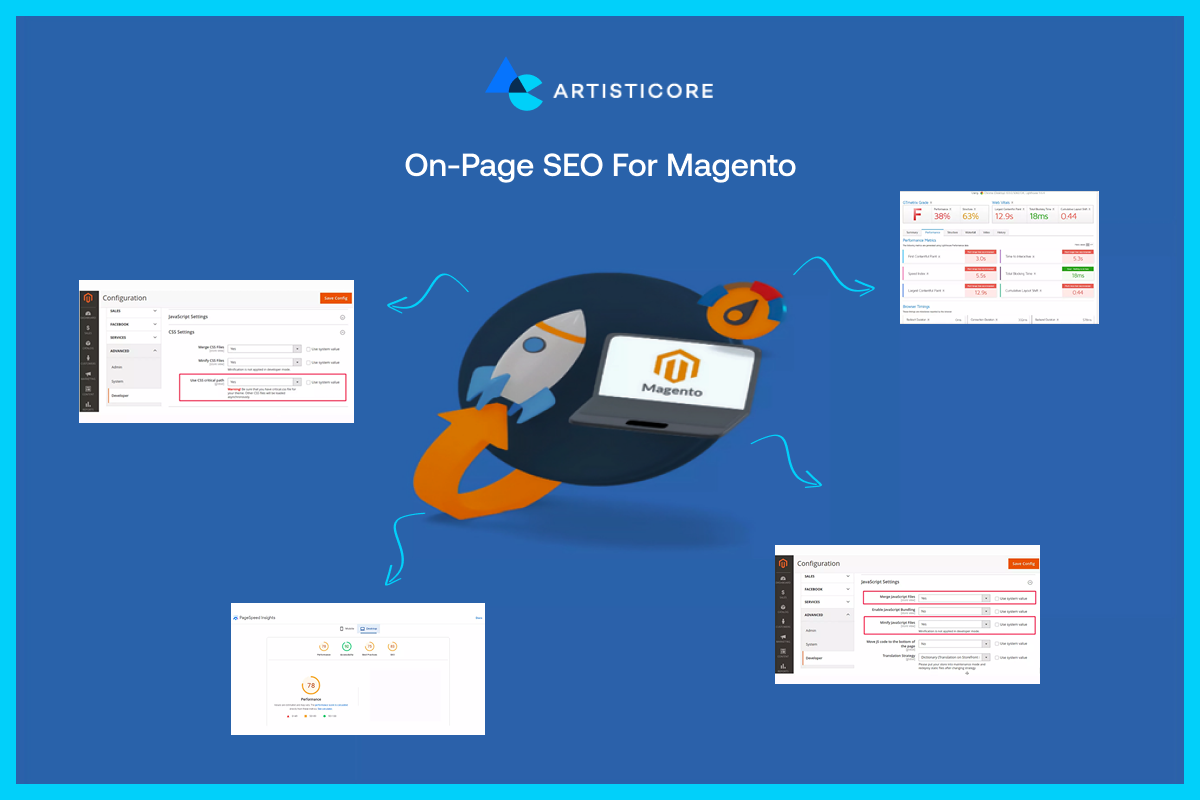
Site speed is not merely a technical factor, but it is one of the largest SEO elements of eCommerce.
Research indicates that even a one second delay when loading speed can reduce conversions by 7%. Over half of mobile customers abandon a site that takes over 3 seconds to load.
In the case of Magenta, where customers go through hundreds of items at a time, the speed can break or make sales.
Hosting Matters First
Compared to Shopify or WooCommerce, Magento is heavier. It is easily slowed by poor hosting.
Consider having a Black Friday sale and having thousands of customers flooding your store. When your server is not optimized, your pages crash and you lose customers. This way, all your efforts in to SEO for Magento can go to waste.
When looking for a hosting provider, select one that is optimized to provide speed, stability, and scalability.
Caching for Faster Loading
Consider caching a shortcut. In its absence, each time one clicks a product page, Magento recreates the page afresh. Those pages will be pre-stored with full-page caching.
It means that a user returning to a page will see the product immediately. You know why? Becase Google rewards rankings on speed.
JavaScript and CSS Optimization
Magento loads many scripts on the background. But not all of them are required on-demand.
Minimizing unnecessary JavaScript puts the shopper first. This will also allow the products page to load quickly with important information.
Know that your customer does not require a fancy animation to make a purchase decision. What they need the most is the product picture and price in real time.
Resize and Compress Images
Images boost eCommerce, yet they can also clutter your shop. To avoid this, covert to WebP to reduce the size by up to 30%, that too without compromising quality.
You can also add features like lazy image loading or it only loads when the shopper scrolls. This helps in making the first image to load way faster.
Consider a category page containing 100 products. Enable lazy loading and when the viewer moves forward, the image reveals on its own. This will provide customers with an instant feel and they will be glued to the screen.
Manage Extensions Wisely
The marketplace is full of tempting extensions of Magento. But they all increase the weight of your site.
For example, a fancy slider or chat box could be pretty, but slowing down your checkout page costs your business.
You must audit your extensions every quarter and retain only those that are adding value.
Review Performance
Magento websites are dynamic. They change with new products, seasons, and designs. That is why it is important to have a frequent observation.
Google PageSpeed Insights and Lighthouse identify problems early. You can use them to make small adjustments today and save bigger SEO troubles tomorrow.
Also, never neglect to test site speed in desktop and mobile. Mobile-first indexing means that Google considers your performance on mobile first and then determines the ranking.
At Artisticore, we specialize in SEO for Magento services. Need to build a more
profitable store? Our Magento SEO specialists can assist you in speeding up your
Technical SEO for Magento
Imagine technical SEO as the backbone of your Magento store. Without it, even the excellent product descriptions and keywords may remain unrecognized.
Search engines require a clear and error-free structure in order to comprehend your site. With a poor technical setup, your effort in content and design will not yield.
Structured Data and Rich Snippets
Have you ever seen some Google results with product ratings, prices, or stock availability? That is structured data in action.
With schema markup on your Magento store, you are providing Google with a cheat sheet of what you offer. It focuses on the information that your customers are interested in and brings your listing to attention.
It allows shoppers to see reviews and in-stock on the very results page which results in additional clicks.
Mobile Optimization for Shoppers
The majority of the population uses their phones to shop. This is why Google verifies your mobile version prior to ranking you.
Magento themes are mobile friendly but sometimes custom design or excessive features may break the design.
Moreover, when images fail to resize properly or certain buttons are difficult to press, customers move away fast. To identify such problems early, you can use Google Mobile-Friendly Test to test your store regularly.
Site Security and Trust
Trust is everything in eCommerce. Imagine a shopper is about to make a purchase and quits because there’s no little lock icon in the browser. That lock is an HTTPS that indicates that your site is safe.
All Magento stores must have an SSL certificate on all pages and not only on the checkout. By doing this you keep Google happy and assure customers that their data is secure.
Identify and Correct Magento SEO Issues.
The larger your catalog, the more likely you will experience technical issues. Issue such as broken links, duplicate SKUs, or missing photos. Not only do they frustrate shoppers but also, they confuse search engines.
Conducting regular scans using an application such as Google Search Console or Screaming Frog is important. They work just like healthcare check-up on your store.
Addressing minor problems immediately helps to ensure that they do not escalate into larger SEO problems in the future.
Stores that include structured data can frequently increase the click-through rates up to 30 percent, merely due to the appearance of more appealing listing in the search results.
Off-Page SEO for Magento
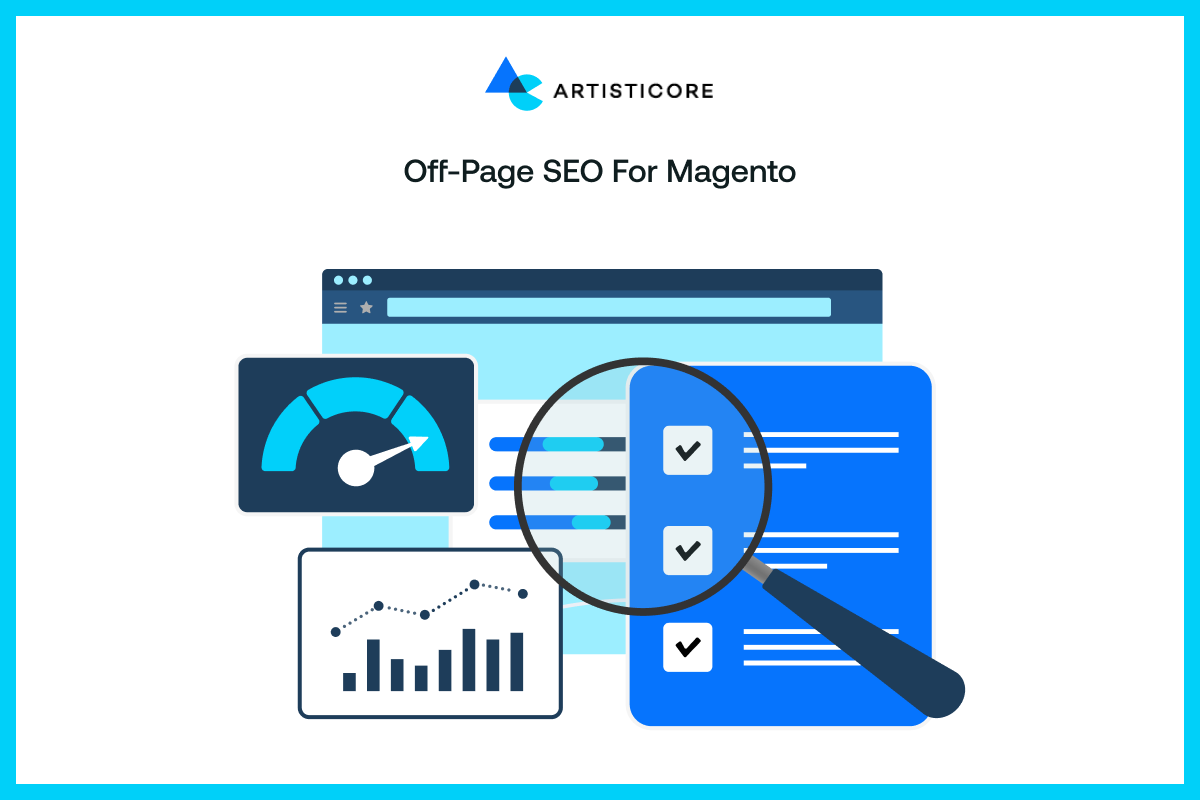
Look for Backlinks
Imagine backlinks as votes of trust. When a different site links into your Magento store, they are virtually telling you that this store is worth visiting.
Google takes these signals to determine the credibility and relevance of your site. Even the best-optimized store may find itself unable to rise higher through search listing without good links.
Create Authority with Content
It is one of the most effective methods to achieve links because people want to share the content that is really worth sharing.
Suppose you are going to write a guide about selecting the right running shoes to your sports store. Bloggers and forums, and even other retailers may mention it as it is useful.
It is this kind of content marketing strategy that attracts links and allow new shoppers to trust in your expertise.
Partnerships that Boost SEO
In case you have connections with suppliers, influencers, or bloggers, you can use them to your Magento SEO.
For example, request a supplier to include your store on their Where to Buy page. Or have an influencer go through your products and refer to your site.
These aren’t just SEO-friendly links, they are attracting real traffic of people already interested in your products.
Local Directories
Directories may be outdated, but they may still be relevant when used wisely.
An example of this would be a fashion retailer being listed on local directories of style or trade associations.
Having the right directory is beneficial to ecommerce Magento SEO as it is an indicator of relevance to both search engines and shoppers, seeking reliable choices.
Social Signals
Although, social media links cannot directly increase the ranking, they increase your visibility. Bloggers can write about your product based on a viral Instagram post and this creates real backlinks.
Each share, mention, tag is a chance that your brand can be seen beyond the Magento ecosystem.
Tracking What Works
Not all links are equal. One recommendation by a leading magazine in your field can work better than 50 random links with poor-quality blogs.
You can use tools such as Ahrefs or SEMrush to monitor the sources of your backlinks and determine whether they are actually benefiting your Magento SEO optimization. Take it as quality control of your link-building work.
SEO for Magento Tools
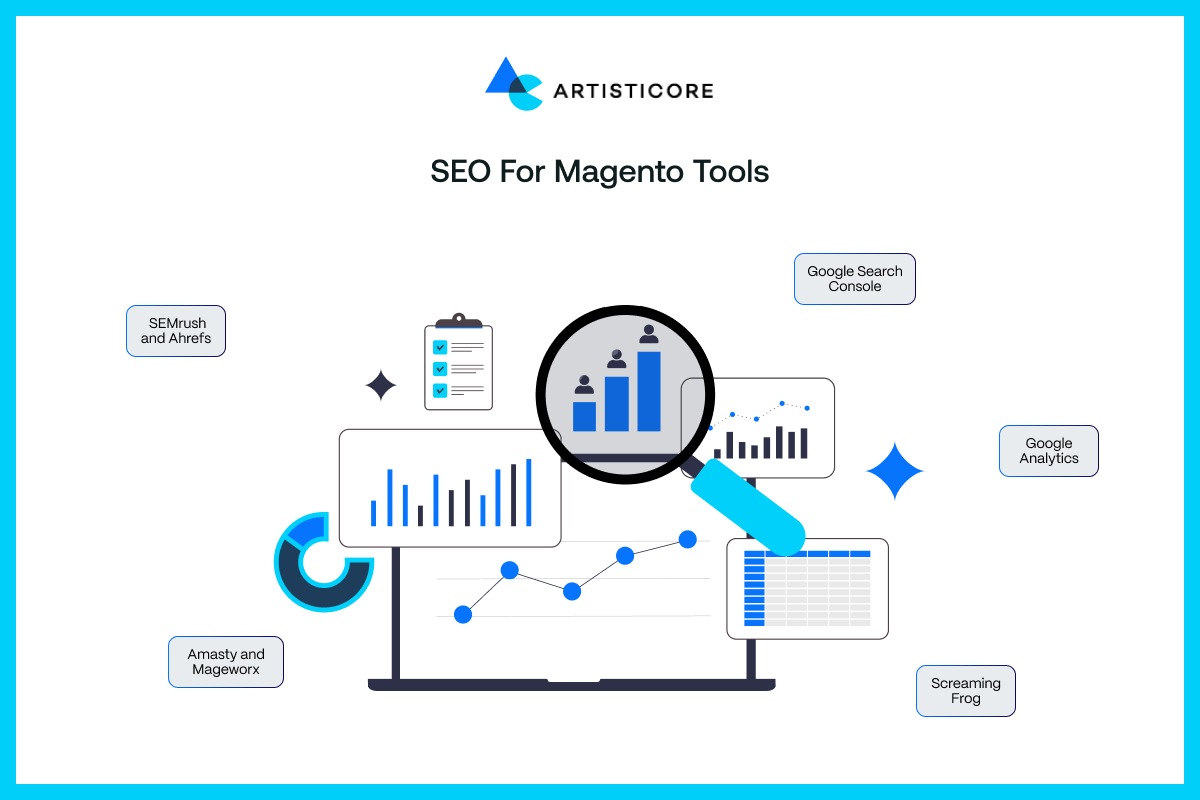
Operating a Magento store, having to handle SEO manually may be daunting. There are tools for it that you must know how to operate.
Google Search Console and Google Analytics
Google Search Console is the first tool, that you must have. This will tell you which pages are being indexed, what keywords are getting visitors, and even whether there are crawling problems.
Combine it with Google Analytics to find out what the users do after arriving on your site.
SEMrush and Ahrefs
Search engine optimization tools such as SEMrush and Ahrefs can help you monitor your positions. These will also monitor your competitors, and find new keywords to pursue.
Screaming Frog
Another personal favorite is Screaming Frog. It crawls your site like Google and therefore you can immediately see broken links, duplicate titles, or missing tags.
Amasty and Mageworx
SEO extensions such as the SEO Toolkit of Amasty or the SEO Suite of Mageworx simplify optimization. This way, you can automate meta templates, generate sitemaps, and work with rich snippets.
These tools do not substitute strategy but, they will make the process quicker and more precise. The correct combination is the way to make your SEO of Magento effective and data based.
Cost of SEO for Magento
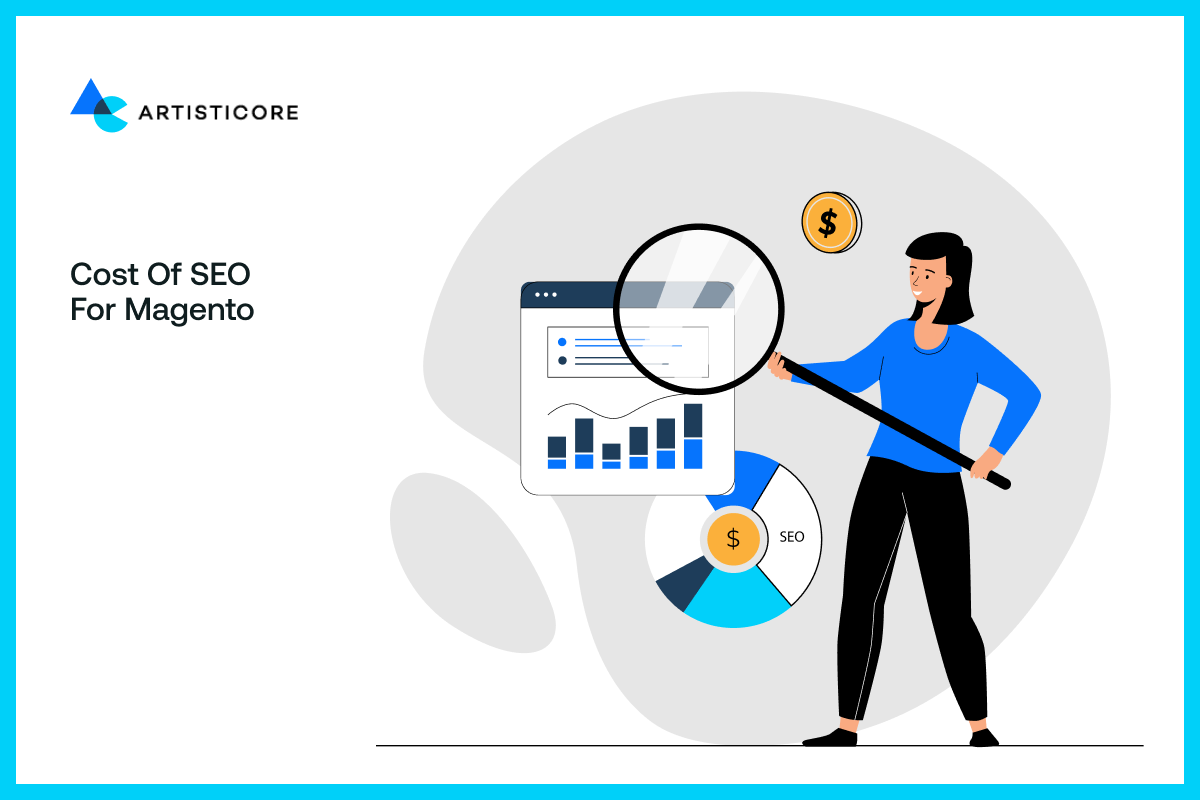
The question that many store owners would to ask, how much will SEO cost me? The answer lies in how you do it.
When you do it yourself, it only costs you time and some tool subscriptions. It works when your store is small and you are not afraid to learn.
Freelancer or small agencies tend to cost as much as $500-1500 a month. Whereas, full-service agencies like Artisticore would cost between $2,000 and 10,000 per month. That too depend on the level of work.
Enterprise-level Magento SEO projects, which involve complex site structure, thousands of products, and international targeting tend to be even more expensive.
Work On Your Mindset
You can only make a different if you look at SEO as an investment, rather than an expense. When you invest in optimization, your Magento store attracts regular traffic, reduce the need for advertisements, and creates long-term visibility.
That is, an investment in SEO can have a long-lasting payoff.
Magento SEO Issues to Avoid
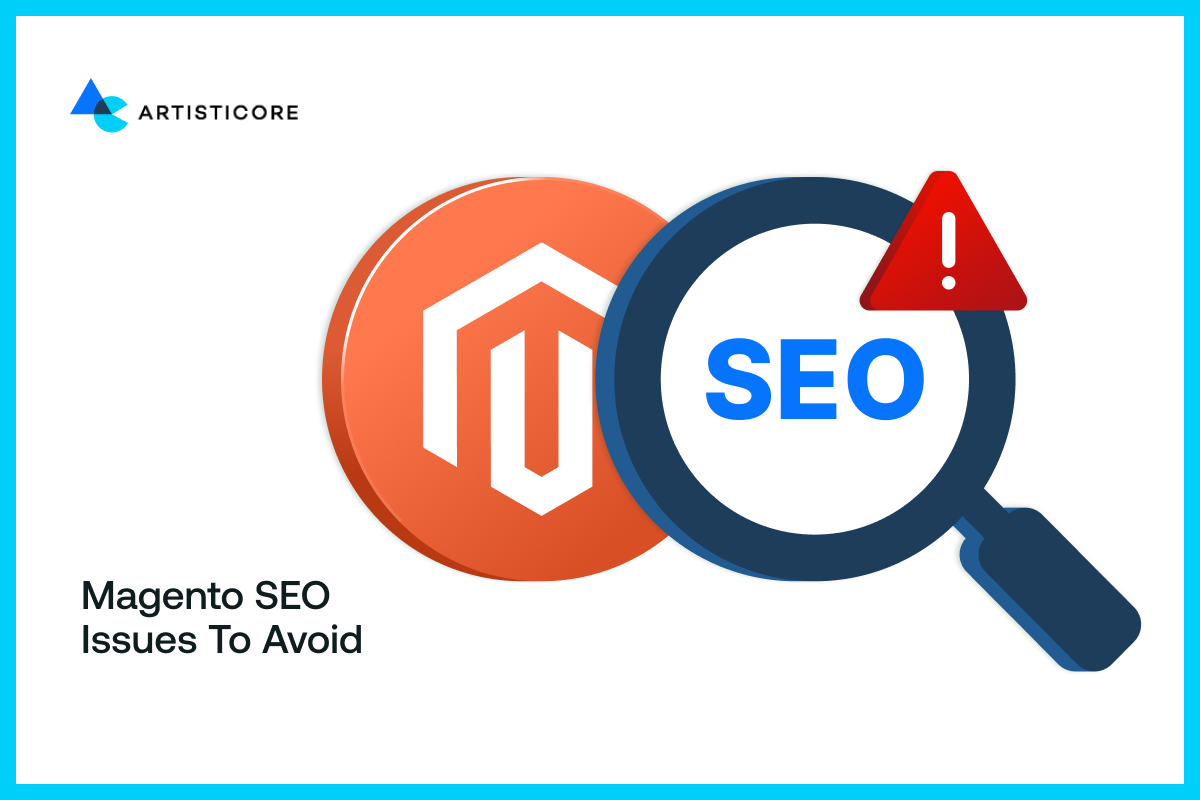
Magento is very potent on its own. But it is easy yet easy to go wrong with it.
Using Duplicate Content
One of the most common mistakes that people make is using duplicate contents. Repeated content based on category paths, facet navigation, or session IDs can lead to a huge lose. Google views multiple versions of the same page without canonicals or noindex rules.
Too Many Features
The second error is to overload the site with extensions. Although they are adding features but having too many slows down your store.
This affects the site speed which negatively affects user experience and SEO. Remember, disregarding mobile speed is also dangerous because slow pages lose visibility.
Unstructured Data
There are also businesses that do not focus on having structured data. You can add structure by focusing on few things like displaying prices, ratings, stock levels, and rich snippets.
By adding the structure, you have the ability to improve the rate of click-through. And missing on them means missing out on greater site visibility.
No Monitoring and Updating.
Finally, most owners view SEO as a one-off project. As a matter of fact, Magento SEO needs continual monitoring and updating.
Trends on search engine vary, products appear and disappear and competitors evolve. The only way to make sure that your hard work will pay off is to avoid these errors.
Magento SEO Checklist
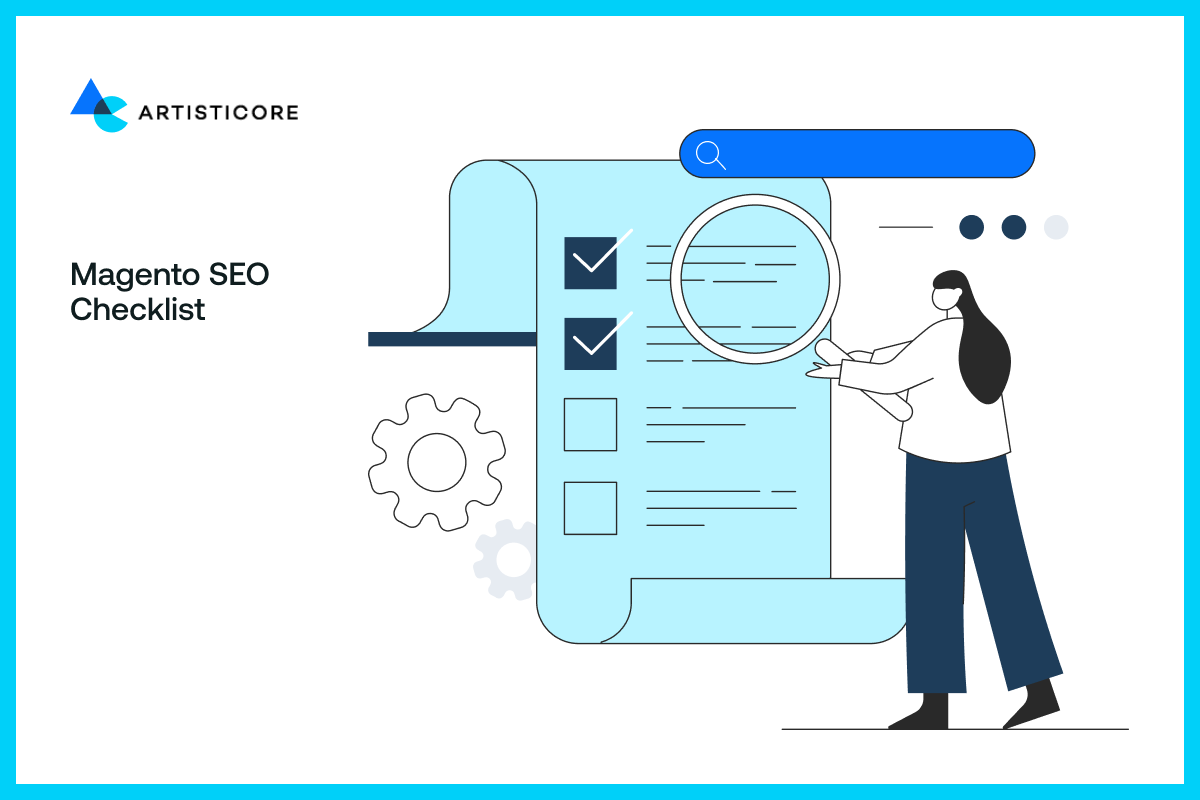
Even if you do not understand how to do SEO for Magento website, then go through this checklist. This is the fastest way to optimize your Magento store
- Maximize the on-page search engine optimization through titles and descriptions.
- Set up Magento 2 SEO settings, such as robots.txt, canonical tags, and sitemaps.
- Enhance search either through the layered navigation or filters do not duplicate content.
- Take advantage of Magento 2 SEO guide that talk about customizable URLs and image alt tags.
- Check performance on a regular basis.
- Use Magento 2 best practices to beat competition.
Such a checklist of a list is structured such that you can cover all the corners, including Magento commerce SEO and Magento enterprise SEO.
How SEO Magento Contribute to eCommerce Success
The fact that Magento is a flexible, people often disregard doing SEO of their store. Search visibility is important whether you have a small Magento site going on or a magento enterprise.
With the effective SEO eCommerce Magento strategy, your store will be prominent in search results. It will get the right audience, and convert visitors into buyers.
It is also SEO for magento 2 that will attracts organic traffic, increases conversions, and reduce paid ads cost. Consider it the long-term marketing of your Magento store, scalable, cost-effective and steady.
Conclusion
SEO for Magento is not a simple check box. It is a process of creating a store that the search engines trust and customers adore.
Every element contributes to the bigger picture. Whether it is technical corrections or the creative acts, you need to focus on the possible errors.
Imagine it is a long ride. But with steady magento improve search, you will start to see the gains.
The best thing about Magento is that it is flexible. With proper SEO plan, you can grow from a small shop to a global corporation.
Eventually, Magento SEO deals with visibility, trust, and conversions. When done correctly, it makes your store more than just another site customers visit. It becomes a trustworthy brand they can locate and select.
Willing to unlock the potential of your Magento store?
